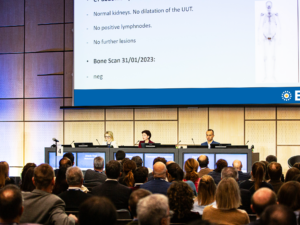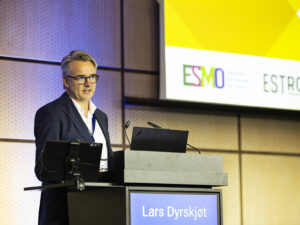Following lively multidisciplinary case discussions in Plenary Session 4 at EMUC25, which covered multiple carcinoma in situ (CIS), as well as the management of very high-risk non-muscle invasive bladder cancer (NMIBC), the session continued with presentations on Bacillus Calmette-Guerin (BCG) therapy, and urinary biomarkers for monitoring NMIBC, before closing with a review of the most cost-effective treatments for NMIBC.
“BCG failure is defined as any high-grade disease occurring during or after BCG therapy” said Dr. Chiara Mercinelli (IT) in her lecture on ‘Failure after BCG systemic treatment”. How does this happen? According to Dr. Mercinelli, BCG treatment increases the expression of PD-L1, Tregs, and tumour-associated macrophages, creating an immunosuppressive microenvironment over time. “This PD-L1 upregulation is one of the key mechanisms of immune escape and ultimately explains why some patients become BCG-unresponsive.”
What are the options? Dr. Mercinelli shared the key results of several novel therapies, before summarising these key take-home messages:
- Systemic checkpoint inhibitors restore T-cell function and can enhance or complement the anti-tumour activity of intravesical agents.
- Pembrolizumab is already FDA-approved for CIS BCG-unresponsive, confirming a clinical role for systemic therapy (complete clinical response at 6 months: 36%).
- Trials combining local and systemic therapy (CG0070 + pembrolizumab) show the highest clinical response rates in early-phase trials. Targeted therapy is a valid approach in the NMIBC population.
- Robust randomised trials to compare intravesical and systemic versus intravesical alone are urgently needed to define optimal sequencing and combination strategies.
Prof. Carmen Jeronimo (PT) presented on “Urinary biomarkers for monitoring of NMIBC”. She noted that NMIBC represent the majority of all bladder cancers and have a high recurrence (up to 70%) and variable progression (up to 20%), necessitating life-long surveillance. In her opinion, biomarkers offer the potential to reduce unnecessary cystoscopies and anticipate the identification of high-risk patients in NMIBC. “Urinary biomarkers are ideal for risk-adaptive surveillance – balancing patient burden and recurrence detection.”
She emphasised the need for further validation of the best-performing biomarkers in diverse real-world settings (different populations, different hospitals) and their implementation in clinical practice. She also highlighted that combing biomarker panels with AI driven multimodal surveillance could help individualise NMIBC follow-up.
What is the most cost-effective treatment in NMIBC failure?
According to Prof. Ashish Kamat (US), current options for patients in NMIBC failure are extensive and include immunotherapies, chemotherapy, a combination of both, gene therapies, targeted therapies, device-assisted therapies, and radiotherapy plus immunotherapy. But patients face many treatment considerations, including short-term cure versus short-term gain, quality of life, logistical challenges, anxiety, potential long-term side effects from drugs, and financial toxicity.
Prof. Kamat shared new research (Myers, Talwar et al. 2025) assessing the financial toxicity of five treatments: radical cystectomy, nadofaragene, nogapendekin/BCG, pembrolizumab and gemcitabine/docetaxel, as well as the study CISTO (Gore J, et. al 2025) on the financial impact of bladder-sparing therapy versus radical cystectomy.
He concluded that cost-effectiveness varies by treatment strategy and patient goals, but radical cystectomy remains the most cost-effective overall. Among bladder-sparing therapies, gemcitabine/docetaxel is the most-cost effective single-line option. He noted that multiple sequential therapies offer limited (financial) value, and in his final in comment he stressed that shared decision making is as important as ever.
Visit the EMUC25 Resource Centre to see their full presentations.





